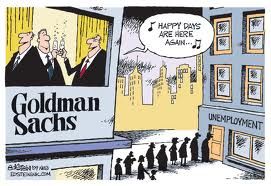Cross posted from The Stars Hollow Gazette
The former special inspector-general of the troubled asset relief program (TARP), Neil Barofsky says that it is time for a “post mortem” analysis former Treasury Secretary Timothy Geithner’s doctrine, the preservation of large banks, the largesse of Wall St. and the perversion of of the US criminal justice system. In this article posted at naked capitalism, Mr. Barofsky looks at the effect of the “Geithner Doctrine” and the weak response to the LIBOR scandal:
The recent parade of banking scandals, such as the manipulation of Libor rates by Barclays, Royal Bank of Scotland and other major banks, can be traced back to the lax system of regulation before the financial crisis – and the weak response once disaster struck.
Take the response of the New York Federal Reserve to Barclays’ admission in 2008 that it was submitting false Libor rates and was not alone in doing so. Mr Geithner’s response was to in effect bury the tip. He sent a memo to the Bank of England suggesting some changes to the rate-setting process and then convened a meeting of regulators where he reportedly described only the risk but not the actual manipulation of the rate. He then put the government imprimatur on the rate via bailout programmes. His inaction helped permit a global crime to continue for another year.
When it was UBS’s turn to settle its Libor charges, even though a significant amount of the illegal activity took place at the parent company level, only a Japanese subsidiary was required to take a plea. Eric Holder, US attorney-general, demonstrated his embrace of the Geithner doctrine (a phrase coined by blogger Yves Smith) in explaining the UBS decision. He said that a more aggressive stance against the parent company could have a negative “impact on the stability of the financial markets around the world”.
This week we saw the latest instalment of the saga. In fining RBS £390m, the DoJ only indicted one of the bank’s Asian subsidiaries, avoiding the more damaging result that would have stemmed from charging the parent company.
Instead of seeking deterrence and justice, the US government increasingly appears to have fully absorbed the Geithner doctrine into its charging decisions by seeking a result that has a minimal impact on the target bank but will generate the best-looking press release. Some banks today are still too big to fail – and they are still too big to jail.
There are no meaningful consequences for this criminality. The fines with a promise not to do this again are just a game to allow the banks to continue the fraudulent conduct and find better ways to cover it up. Mr. Barofsky concludes that we must ditch the “Geithner Doctrine” to end “the game of incentives gone wild, and the lack of accountability in the aftermath of the crisis has only reinforced those bad incentives.”
o reclaim our system of justice, the global threat posed by the failure of any of our largest financial institutions must be neutralised once and for all. They must be reduced in size, their safety nets must be dramatically constricted and their capital requirements enhanced far beyond the current standards. Then, and only then, can the same set of rules apply to all.
In an extended interview with “The Daily Show“ host Jon Stewart, Mr. Barofsky discussed the double standards of the TARP program and the alien culture of Washington DC and explains why the banks will never face true justice..

 After receiving a $10 billion of tax payer money in the financial crisis bailout and making a record $2.7 billion profit in the first quarter of 2011, Goldman Sachs will lay off 1,000 American workers and
After receiving a $10 billion of tax payer money in the financial crisis bailout and making a record $2.7 billion profit in the first quarter of 2011, Goldman Sachs will lay off 1,000 American workers and